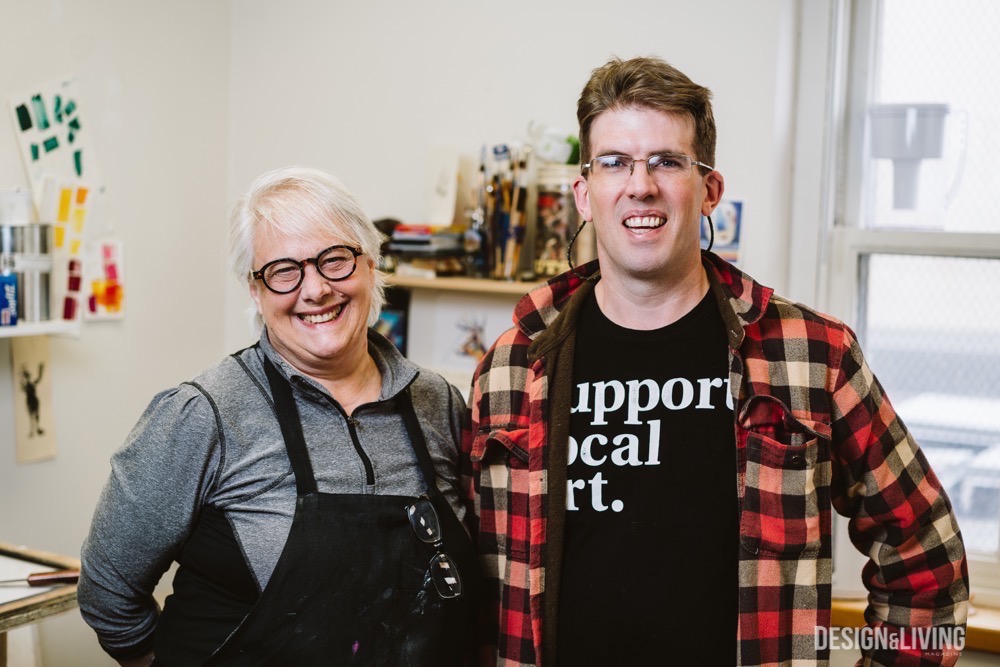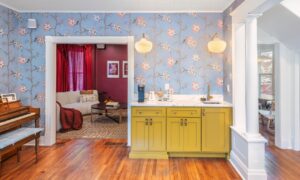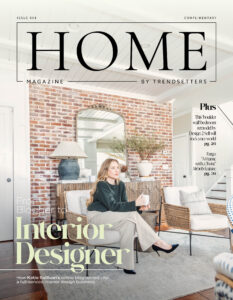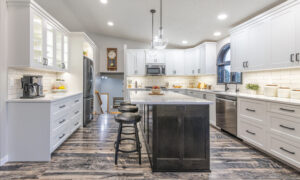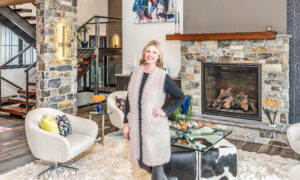PHOTOGRAPHY BY PAUL FLESSLAND
Printmaking is an artistic medium with a language all its own. Though some readers may be familiar with screen printing, there are many other printmaking techniques to explore. Here to help us do just that are Cameron Peterson and Nettie DuBord of Fun House Press. Join us as we tour their tiny studio and see where the magic happens.
THE ARTISTS
Peterson and DuBord first met when they were students at MSUM. Today, they are a couple and have their own printmaking studio called Fun House Press. “We just don’t like the idea of Serious House Press,” Peterson laughed.
Peterson mostly works with monotypes and linoleum cuts, while Dubord focuses on polymer plate lithography.
MONOTYPES
Every monotype print is unique. This technique involves creating an image on a nonabsorbent surface, or matrix, and transferring that image onto paper. Because almost all of the ink is used when producing one print, the printmaker has to reapply the ink to the matrix for each subsequent edition. Although the printmaker may use the same image over and over again, subsequent editions of a monotype print have subtle differences from their predecessors because the ink is applied differently each time.

LINOCUT PRINTS
Linocut prints involve cutting a design into a piece of linoleum, applying ink to the surface, and using it like a stamp to transfer the design onto a piece of paper. This can be done by hand or by using a press.

Though he recently had his work on display at the Rourke Art Museum, Peterson’s newest project is a linocut series of the fifty states.


Peterson’s newest project is a linocut series of the fifty states.
“I Like the ritual of cutting and making a print.” – Cameron Peterson
Peterson has also taught after-school classes. “I was talking to little children and I was using all this printmaking jargon and I could see their eyes roll back into their heads. Then one kid goes up and said, ‘So you make really cool stamps?’ And I said, ‘Yeah, that’s what I do,'” Peterson smiled.
POLYMER PLATE LITHOGRAPHY

When describing polymer plate lithography, DuBord said, “Litho is kind of like magic because it looks like it should not work, but it does.”

Polymer plate lithography involves drawing on a treated polyester plate with a grease medium, which makes the drawn areas ink-loving and the undrawn areas water-loving.
Ink and water don’t mix, so ink adheres to the plate. Then, paper is placed on top of the plate with a tympan, which acts as a buffer that ensures pressure is distributed evenly. Finally the paper, plate and tympan are sent through the press and the image is transferred onto the paper. This process can also be done by hand.
Unlike traditional lithography, which uses a stone or aluminum plate, polymer plate lithography is non-toxic and economical because it needs none of the harsh chemicals used for etching and cleanup.

Though she has experimented with polymer plate lithography, DuBord wasn’t always a printmaker. “I’ve been interested in art all my life, but never acted on it until I turned thirty,” DuBord said. “I went to Moorhead State and enrolled in the art department, took several classes and printmaking sucked me in.”

DuBord continues to seek out further knowledge of lithography by attending workshops and learning from fellow artists. “It’s always good to learn from another artist’s perspective in polymer plate lithography,” said DuBord. In addition to attending workshops with Amanda Heidi at the Plains Art Museum, DuBord was able to participate in an extremely reputable printmaking workshop last year.

“Cameron gave a wonderful present to me. He paid the tuition for me to go to Frogman’s Printmaking Workshop in Omaha, Nebraska, last summer, and that’s one of the top printmaking workshops in the country.It’s a great community of printmakers—a great sharing environment,” DuBord said of the energizing experience.

Recently, DuBord made 200 prints for Giving Hearts Day. “That was a challenge. I didn’t think this process could print 200, but I did it,” DuBord explained.
A SUSTAINABLE STUDIO SPACE
Fun House Press has been in their studio for four years now. Though it is small, Peterson and DuBord have made good use of their space. For example, Peterson and a friend designed and built work stations anchored to the walls that fold down if needed.

As the name of their studio suggests, DuBord has fun with her art.


“The dream someday is something bigger, but for now we’ve made an economical use of a small space. You use the space you have, and it works. We do what we do and it makes us happy,” Dubord said.
The couple also share a communal space outside of their studio with neighboring artists.
In addition to making their space efficient, the artists of Fun House Press try to reuse materials and reduce the amount of toxins produced during the printmaking process.
“I am very rarely serious. I’d go crazy if I had to do serious and dark. If it makes me laugh, I’m happy. If people look at my work and start laughing, I’m thrilled.” – Nettie Dubord
DuBord said, “Traditional lithography is very toxic and you need very good ventilation.”
“We’ve tried very hard to keep this as chemical-free as we can,” Peterson added. Their secret is vegetable oil, which they use to clean the oil-based lithography ink.:
Fun House Press
701-219-9605
109 1/2 Broadway N. Unit L, Fargo
quareup.com/market/fun-house-press
You can also find them on Facebook.

